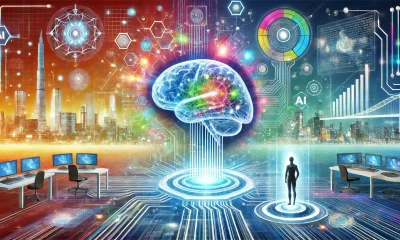Artificial Intelligence
5 Computer Vision Applications in 2022

Computer vision is a technology based on Artificial Intelligence. It trains systems to pull meaningful information from visual data, including images and videos. CV uses digital images and videos from cameras and deep learning models to discover and classify objects and take automated actions.
The article explores the most common computer vision applications and their benefits in the real world.
5 Computer Vision Applications
Computer vision works by replicating human brain capability by recognizing visual information. It uses pattern recognition algorithms to train systems using large visual datasets. Advancements in neural network technology are enabling rapid progress of these algorithms. For example, retail store automation analyzes images and videos to automate checkout and inventory management.
Let’s discuss the five industries having several computer vision applications.
Transportation
CV plays a crucial role in making the industry safer and more efficient by enhancing customer experience and revenue generation. From self-driving cars to traffic flow analysis, the Intelligent Transportation System (ITS) has become critical in today's high-tech world.
The computer vision applications in the transportation industry include.
- Self-Driving Cars: Autonomous vehicles are the most common computer vision application in the transportation industry. The technology leverages object detection algorithms to detect and classify objects in the car's surroundings. For example, road signs, pedestrians, barriers, and other vehicles, to safely navigate the road.
- Traffic Flow Analysis: Traffic flow tracking and estimation have been made possible using footage obtained from drones floating over an intersection. The technology helps observe traffic flow and measure traffic variables required by traffic engineers.
Medicine & Healthcare:
Medicine and healthcare have undergone great advancements using computer vision technology. The technology is used to improve medical treatments and procedures, accelerating healthcare research and improving patient experience.
Here are the two computer vision applications in the medicine and healthcare industry.
- Cancer detection: Computer vision systems are trained using ML and deep learning models with data from healthy and cancerous tissues to detect cancer in patients accurately. A breast cancer study found the technology more efficient than human radiologists.
- X-ray Analysis: Radiology is one of the first medical disciples to adopt CV-enabled medical applications. Object recognition algorithms combined with CV are used for computer-aided inspection of X-rays, MRI, and CT scans of internal organs. CV enables the detection of bone fractures and treatment results monitoring and change detection in radiology.
Public Relations & Advertisements
Businesses in this industry are using CV for better marketing and communications decisions. The technology helps analyze consumer actions and enables marketers to analyze user behavior and their response to ads.
Two applications of computer vision technology in the industry include.
- Tracking Consumer Attention & Emotions: CV uses face analysis algorithms to analyze consumer facial expressions and identify their emotions and responses to certain ads. Consequently using emotion detection technology in CV, marketers today predict sales revenue, measure foot traffic, and set their marketing strategies accordingly.
- Virtual Product Application: Different shopping brands today integrate augmented reality and CV to create a virtual shopping experience for customers. For example, Sephora Virtual Artist is a mobile app that lets you upload your photo and apply different products on your face virtually to enhance your product selection experience.
- AI-powered image editing: Another computer vision application is AI-powered image editing, where the technology is used to detect objects in an image and separate or change them from the background. For instance, a company known as Removal.AI leverages CV technology to function as a background remover.
Manufacturing Industry
CV helps identify problems and optimize supply chain processes in the manufacturing industry. For instance, product and quality inspection and supply chain management.
Two common computer vision applications in manufacturing include.
- Reading texts and barcodes: Since most products have barcodes on their packaging, the industry uses a computer vision technique known as OCR that can automatically detect, verify, convert, and translate barcodes into readable texts.
- Product assembly: Computer vision plays a critical role in product and component assembly in manufacturing. The industry is implementing computer vision to run fully automated product assembly and management processes.
Agriculture
Computer vision is employed in agriculture to help overcome several challenges, including climate change, labor shortage, etc. The technology enables field evaluation and crop disease detection and helps predict weather and crop yields.
The agriculture industry increasingly uses AI and ML models. This includes computer vision for crop and yield monitoring and product defect detection. With proper mechanical equipment, the technology can provide time savings.
Here are the two computer vision applications in the agriculture industry.
- Crop and yield monitoring: Computer vision enables plant growth monitoring and detection of any infectious disease that can destroy the crop field. Hence, this technology has improved yield estimation processes.
- Insect Detection: Manual insect detection is ineffective and labor-intensive. CV technology uses real-time object detection algorithms for insect detection. It enables vision-based counting and recognition of flying insects that destroy crops.
The Future of Computer Vision Applications
Computer vision technology uses deep learning models and AI neural networks to replicate human vision. It provides us with valuable insights, enhancing our quality of life. With further research and refinement of the technology, we will see a broader range of functions. Not only will the technology become easier to train but also discover more from its surroundings.
The technology has the potential to unlock many new and useful applications. Also, CV can be combined with other technologies or AI subsets to build more potent applications. For instance, enabling businesses to engage with real-time objects in a multidimensional space.
Furthermore, CV will aid in artificial general intelligence (AGI) development and enable it to process information even better than the human visual system.
Learn more about data, Computer Vision, and other latest trends in technology with unite.ai.














